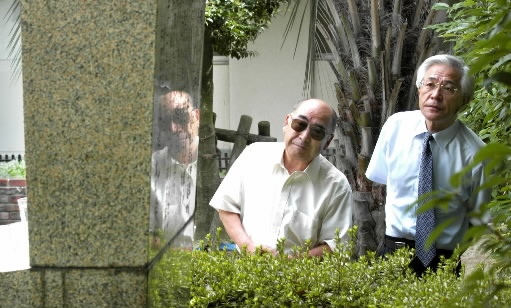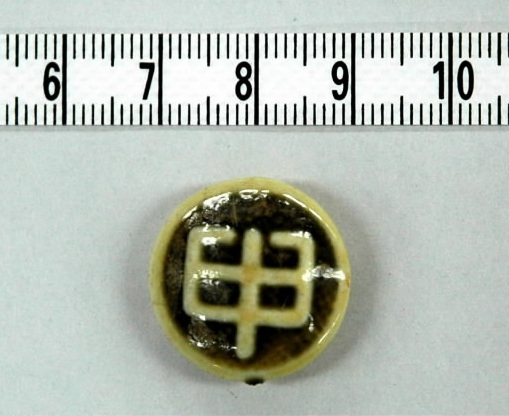Ninoshima Island, Awakening from Slumber, Part 3
Jun. 28, 2010
Ceramic button leaves lone survivor
by Kunihiko Sakurai and Aya Kano, Staff Writers
Fifty-nine years after the dropping of the atomic bomb [this series was originally published in July 2004], the remains of many atomic bomb victims are being found on Ninoshima, a small island off the coast of Hiroshima. The fact that they are just now being exhumed reveals the vast scope of the devastation wrought by the bombing. The brittle, dark brown bones are reminders of the long years that have elapsed, forgotten by the public. In this series the Chugoku Shimbun examines how we should remember the atomic bombing experience and how we should convey that experience to the next generation.
A photograph captures the stern expressions of 64 innocent youths with close-cropped hair. It was the spring of 1945 and they were new first-year students at Sanyo Industrial School (now Sanyo High School). "This is me," said Mikio Miura, 71, a Hiroshima resident, pointing to himself 59 years before. "All the rest of my classmates are gone."
Their collars differ, and some of their uniforms have pockets while others do not. But the buttons on all of their uniforms are the same. They were made of ceramic because metal was confiscated during the war. Those buttons changed Mr. Miura's destiny.
Just past 8 a.m. on the morning of August 6, Mr. Miura was in Zakoba-cho, now part of Hiroshima's Naka Ward, where he and other students were helping to dismantle buildings to form a fire lane. As he and his classmates ran to gather for the morning meeting, Mr. Miura realized that one of the buttons on his jacket was about to come off. The students were always told: "Even one button is a gift from the emperor." Feeling he must not lose the button, Miura asked one of his classmates to answer roll call for him and returned to the air raid shelter. He squatted down near the entrance and took out a needle and thread his mother insisted he carry with him.
It was just then that the flash of the atomic bomb appeared. Before he knew it, Mr. Miura was lying on the ground deep inside the shelter. When he went outside, the city was in flames. All his classmates and teachers were gone.
Surrounded by the injured, he spent the night at the foot of Hijiyama Hill and then headed for the home of relatives in northern Hiroshima Prefecture. He was later reunited with his parents, but his mother died later that year. He went to work for a company, and over the years has recounted his experience of the atomic bombing many times.
This summer he ran across a photo of one of the ceramic buttons in the newspaper. It had been unearthed during the exhumation of remains on Ninoshima. Thinking perhaps it had belonged to one of his classmates, now lingering only in old photos, Mr. Miura contacted Sanyo High School. He visited the school and offered a prayer at the memorial to the victims in the schoolyard.
According to the Record of the A-bomb Disaster and a publication issued to mark the 50th anniversary of a school known as Ishida Gakuen, about 260 students from Sanyo Junior High School and another 150 from the Industrial School, including Mr. Miura, were working to dismantle buildings in Zakoba-cho, just over 1 km from the bomb's hypocenter. All of them were first-year students. Some of them were evidently transported to Ninoshima, but nearly all of them are believed to have died.
According to graduates of the schools, the buttons on the uniforms of Sanyo Junior High School and the Industrial School were of the same design. Through the spring of 1943 they were made of metal, but by 1945 they were ceramic. The ceramic buttons were sold at a school supplies shop. Although it cannot be said with certainty, the button found on Ninoshima very likely belonged to a first-year student, who comprised the majority of the victims. The back of the button bears the number 263, which some believe represents the 2,603-year continuous reign of Japan's emperors, and would correspond to 1943.
The owner of a shop that has sold badges and emblems since before the war said the store had sold buttons for Sanyo Junior High School uniforms during the war, but its records were destroyed in a fire. He said he did not know the name of the contractor who manufactured the buttons or the meaning of the number on the back of the button.
Mr. Miura could say little upon learning of the discovery of the button. His feelings over his fate are torn. As the only survivor, he feels lonely, and he is filled with regret at being unable to save anyone. His classmates, whom he would love to see, are all gone, and it is difficult for him to meet with their families.
As Mr. Miura stood in front of the monument in the schoolyard, Shizuo Masaki, 56, vice principal of Sanyo High School, asked him to talk to the school's students about his experiences, and he agreed. "This will be my apology to them," he said. "Perhaps this can serve as my atonement for having survived." Mr. Miura also decided to attend the memorial ceremony held on the school grounds on August 6 for the first time in many years.
(Originally published July 18, 2004)









